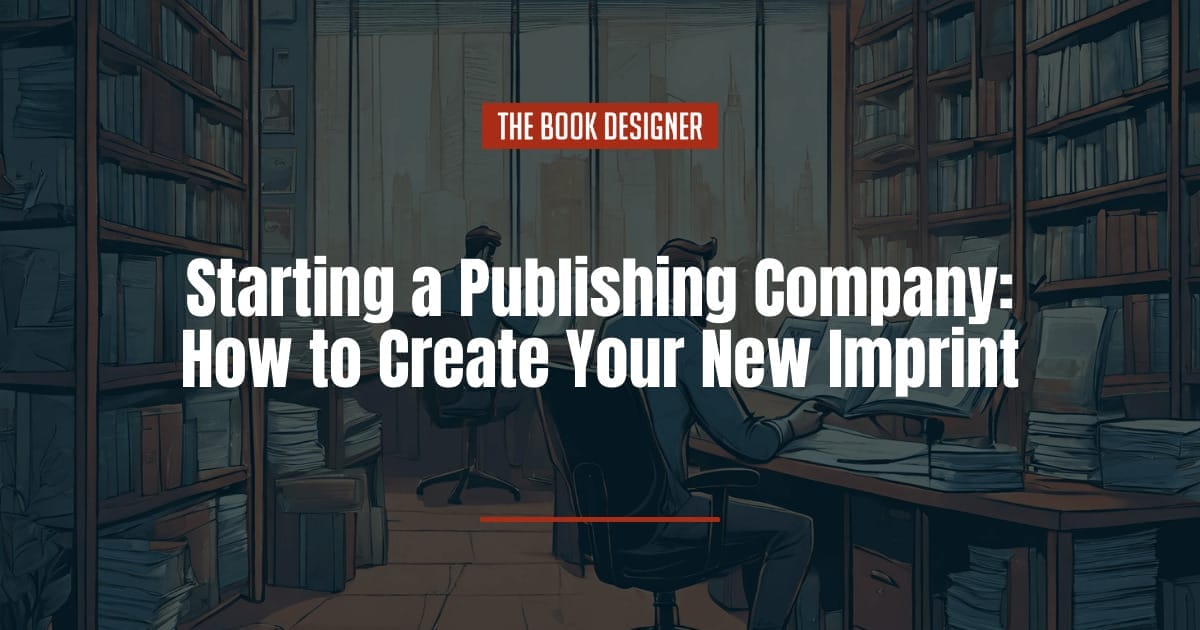When an author decides to publish their own book, there are many questions to be answered. It’s the first of these questions about self-publishing I want to address in this article, and that has to do with starting a publishing company.
Some authors will decide to simply print copies of their book for their own use, or as gifts, or to sell occasionally at private readings or meetings. This type of publishing can be done by an individual without any need for a company structure.
It’s when you decide to approach publishing a book as a business with the intention to market your books to the wider world, list them on online retailers like Amazon.com, try to get them into bookstores, and essentially to become a competitive publisher, that’s when you need to set up a company if you don’t have one already.
Here’s what you need to know about starting a publishing company:
Starting a Publishing Company, Step 1: Set Up & Register Your Business
Some new self-publishers won’t be starting a publishing company from scratch, since they already have a business structure of some kind. Consultants, therapists, and freelance writers, for instance—all candidates for self-publishing—usually do business as a company, and can publish their books in the same way they do the rest of their business.
If you don’t have a company already, you’ll need to start one. The laws of the local area where you live will govern the exact process by which you set up a company. And keep in mind that you should make the decision about what kind of company to have in consultation with an attorney or your tax adviser. There are three basic types of companies that can be book publishers:
- Sole proprietorship—The simplest business model, an operation controlled by you alone.
- Corporation—A commercial entity is created in which you and others hold shares. Most complex business structure.
- Partnership—A contractual relationship in which two or more people exercise control of the company.
Most new self-publishers will undoubtedly decide to be sole proprietors.
The next step is to pick a name for your publishing company and head down to the County Clerk’s office, or whichever government body performs the same functions in your municipality. For example, in Marin County, north of San Francisco, we file a Fictitious Business Name Statement (FBN). Here’s how it works:
- You pick a name and conduct a search in the county records, and the state records, to see whether anyone else is operating under that name.
- You file the form and pay a fee.
- You publish a legal notice in one of the newspapers approved by the County Clerk, for three or four weeks.
In the end, you receive a document certifying that you are operating under the name. In my case, I went through this process when I first started Marin Bookworks.
The advantage is that now you can go to a bank and establish a relationship with the bank as a business. This will come in handy as your company matures and needs more banking or financial services.
Decide whether you want to use your home address, a Post Office box, or the address of a postal-services company like UPS Stores as your business address.
Starting a Publishing Company, Step 2: Get Your ISBNs
The first stop to getting set up in the book publishing industry is to buy your ISBNs. This is the beginning of introducing your company to Bowker, keeper of the basic bibliographic resources in publishing, as well as the ISBN provider and administrator for the United States.
These ISBNs will identify your books but, more importantly, will identify your company as the publisher. Go to Bowker’s MyIdentifiers.com website and pick one of the packages.
- Single ISBN, $125—Bowker advertises this as a good deal for self-publishers, but it looks expensive to me. Especially if you think you might publish more than one book.
- Single ISBN with bar code, $150—This is also advertised as great for self-publishers, but savvy self-publishers know that printers like Lightning Source and publisher-service companies like Amazon KDP will provide you with a barcode of your book’s ISBN automatically and at no charge. There are also free barcode apps online that work just as well.
- Blocks of 10 ISBNs, $295—We have to live with these charges for numbers, so this is your best deal for almost all self-publishers. If you plan to publish at least three books (or three editions of one book), then this becomes the most cost-effective option, even if you don’t use all 10. And since ISBNs don’t expire, you can use them indefinitely.
- Blocks of 100 ISBNs, $575—If you’re planning to be particularly prolific (or if you think you might want to eventually publish other people’s books under your publishing company), this is a great deal, bringing the cost per ISBN under $6.
If you think you might be doing a lot of shipping from your location, you could also purchase a Standard Address Number (SAN) at Bowker, but you can wait on this until your printing and distribution options have been clarified.
Starting a Publishing Company, Step 3: Off to BowkerLink
Armed with your new business name and business bank account, you’re ready to finish your introductions. Bowker provides the Bowkerlink.com tool for publishers.
This free portal allows you to market titles through Bowker products to many sectors of the book industry including wholesalers, distributors, retail chains, independent retailers, online retailers, schools, libraries, and universities.
Bowkerlink.com
Further in Bowker’s site, you will find out that:
- Books In Print® is the leading bibliographic database for publishers, retailers, and libraries around the world.
- Bookwire, powered by the Books in Print® database, makes it easy to search and discover over 20 million book titles, including print, ebooks, audiobooks, and more.
Your data is circulated to all of these customers free of charge and there is no cost for submitting data to Bowker.
You’ll want to register for a free account and fill out all the appropriate fields to register. One of the great resources of BowkerLink is access to the Title Information Record for each of your books. This is where you will fill out the details of your book once you’ve settled on a title, subtitle, and all the edition and pricing information that will complete the record.
When you complete the Title Information for Bowker, your book will automatically be entered in their system, and recoverable with the unique ISBN that you assign to it.
You won’t have the information yet to complete the entire Bowkerlink publisher profile, since you don’t have distributors, discount terms, or a host of other information that will eventually become part of this record. That’s okay, you will be coming back here soon enough.
Why Go to All the Trouble?
You’ve now established your company in the records of the publishing business. Any book you publish with the ISBNs you purchased will be traced back to you and the contact information that you provided. It’s a good idea to keep all these records up to date.
And here’s why it’s worth doing all this: Many successful self-publishers realize that it’s much easier to publish their second, third, and fourth books, particularly in the same niche as their first book. This is how a publishing company can become a real business.
Editor’s note: This post was originally written by Joel Friedlander in 2009 and has been updated by The Book Designer editorial team.




